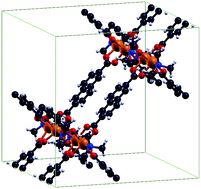Electronic and magnetic properties of DUT-8(Ni)
Abstract
First principles calculations using density functional theory (DFT) have been performed to investigate the electronic and magnetic properties of DUT-8(Ni) (DUT – Dresden University of Technology). This flexible metal–organic framework (MOF) exists in two crystalline forms: DUT-8(Ni)open and DUT-8(Ni)closed. To identify the energetically favoured magnetic ordering, the density of states (DOS) and the energy difference between a low-spin (LS) and a high-spin (HS) coupling ΔELS–HS for those crystalline structures have been computed. Calculations on supercells have been carried out to include a variety of different magnetic couplings beyond a single unit cell. Several molecular model systems have been employed to further investigate the magnetic behaviour by introducing a diversity of chemical environments to the magnetic centers. The magnetic ground state of both crystalline structures has been found to be the low-spin state (S = 0). This low-spin ordering can be seen in the DOS as well as from ΔELS–HS calculations. Additionally, the calculations on the supercells confirm that the local character of the ordering (i.e. within the Ni dimers) is the most favoured one. However, the model systems indicate a change from the low-spin (S = 0) to a high-spin (S ≠ 0) ordering by introducing certain alterations into the chemical environment. Such alterations could be incorporated into the crystalline systems which should lead to similar results.


 Please wait while we load your content...
Please wait while we load your content...